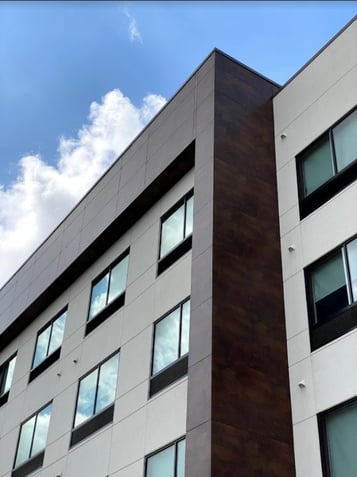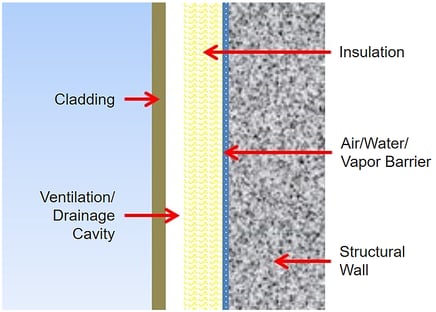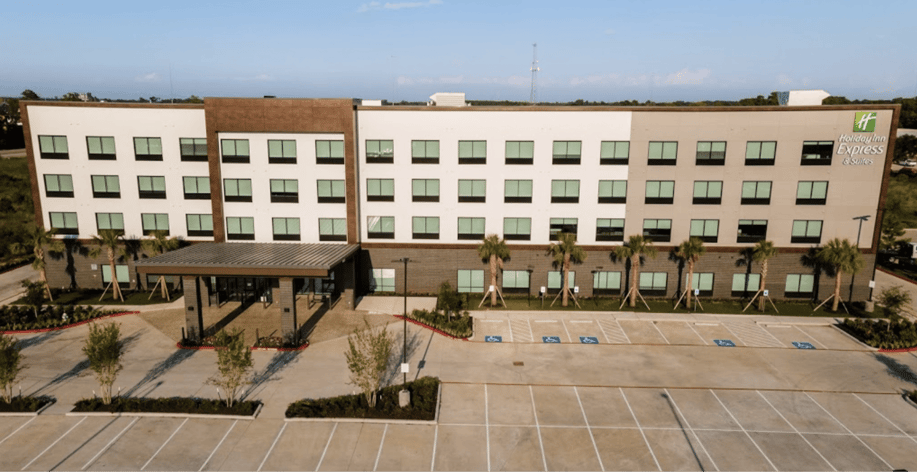.png)
How to Save Money with Rainscreens Over Time
| Last updated August 26, 2025
Rainscreen façades have been gaining traction among architects and builders in the United States in recent years, and for good reason.
In addition to the ingenuity of the rainscreen principle, the impressive long-term benefits and surprising cost-effectiveness of rainscreen façades make them a more viable option than one might initially expect.
What Are Rainscreen Façades?
The primary function of a rainscreen façade is to prevent moisture infiltration according to the rainscreen principle: a wall designed with an open-air cavity sandwiched between two distinct barriers to the outside elements.

Originally, the term “rainscreen façade'' referred to just the outermost barrier (the exterior rainscreen cladding panels), but today a reference to rainscreen façades includes the entire system: the outer façade of rainscreen wall cladding and all of the components behind it.
In addition to moisture prevention, rainscreen façades mitigate a building’s exposure to UV rays, air infiltration, vapor transmission, negative wind pressures, and heat transfer into and out of the building. They also provide the design aesthetic of the building envelope.
There has been a steady increase in the popularity of and demand for rainscreen wall cladding technology as architects, designers, and builders have become increasingly focused on versatility and sustainability in construction and design.
The performance, cost-effectiveness, and long-term benefits of rainscreen façades are evident in both commercial and residential applications around the world.
How Do Rainscreen Façades Work?
As mentioned above, rainscreen façades include multiple layers that work together.

First, the supporting wall may be constructed of any typical material like concrete, brick, wood, or metal studs. This wall carries the weight of the rainscreen wall cladding while also ensuring the building’s stability.
The first layer added to the supporting wall is the air/moisture/vapor barrier layer, followed by a thermal layer of insulation. The thickness of the insulation layer is influenced by the material’s insulating capacity as well as the climate of the project location.
The next layer, the ventilation or drainage cavity, is the trademark element of rainscreen façades and the rainscreen principle. This open-air cavity is open on the top and bottom, promoting water drainage and constant air circulation behind the rainscreen wall cladding layer, which allows water vapor to escape and evaporate.
The façade substructure is the next layer and is the component that allows space for the open-air cavity behind the exterior rainscreen cladding. Architects have several options available for substructure materials depending on the exterior façade material. Substructure options include wood, steel (with galvanized coating), and aluminum.
Finally, exterior cladding panels are mounted to the substructure, functioning as both a design element and as the outermost protective barrier. Choosing a durable, high-quality rainscreen wall cladding material is critical to ensure an effective and efficient rainscreen façade, thereby ensuring that the long-term benefits of rainscreen façades are realized.
Numerous cladding materials are available including wood and metal, but phenolic cladding panels (also called high-pressure laminate or HPL panels) stand out for their low maintenance, durability, and aesthetic appeal.

How Do You Save Money With Rainscreens?
Asking how to save money with rainscreens is necessary in order to properly measure the upfront cost against the long-term benefits of rainscreen façades.
Four key factors contribute to the cost-effectiveness of rainscreen façades:
Energy Efficiency
Rainscreen façades help to reduce the thermal movement through a building wall. This makes the building easier to cool in the summer and heat in the winter, thereby increasing energy efficiency. The increased energy efficiency can mean a reduction in energy costs by as much as 40%, making rainscreen façades one of the most efficient building envelope systems.[1]
Durability
Rainscreen façades provide a layer of durability that protects a building from environmental elements like UV rays and weather exposure. Be sure to consider the specific durability offered by your chosen rainscreen cladding material.
For example, high-quality exterior phenolic wall panels are crafted for ultimate durability, which transfers to the overall durability of the rainscreen façade system.
To test durability, Fundermax conducted a rigorous hail impact resistance test on their phenolic cladding panels (including ice balls up to 2.75 inches in diameter, shot at 67 mph from a distance of 15 to 20 inches from the panel surface), and no breakage, chipping, tearing, or discoloration occurred during the entire test. Regarding scratch resistance, the acrylic surface of Fundermax’s Max Compact Exterior phenolic wall panels is 5x thicker than comparable HPL products.
When compared to other materials that must be regularly repaired or replaced, choosing high-quality phenolic resin panels that resist scratching and do not break, chip, or discolor presents the opportunity for significant cost savings with rainscreen façades.

Longevity
While durability primarily addresses a product’s ability to resist outside forces, longevity refers to whether the product is long-lasting, and the two are not quite the same thing. Essentially, longevity answers the question of how long a product will remain durable. When choosing your rainscreen wall cladding material, it’s critical to consider how long the material will continue to perform as expected from both a functional standpoint as well as an aesthetic standpoint.
Rainscreen façades that use phenolic cladding panels are long-lasting in both form and function. In addition to their impact resistance, exterior phenolic wall panels can be UV-resistant in the form of colorfastness. Here is where paying attention to product quality and warranty is critical.
If the material is not of the highest quality, UV rays can cause fading in wall panels that may be otherwise strong. Specifically, Fundermax’s phenolic rainscreen façades have a greyscale rating of 4-5, indicating the material is reliably colorfast. (Greyscale testing measures visual changes, i.e. colorfastness, on a surface sample when exposed to accelerated weathering.)
Beware of manufacturers with warranties that only cover their product’s durability at certain sun exposures. Fundermax warrants every panel at every angle, in any location.
Low Maintenance
Low maintenance is a significant long-term benefit of rainscreen façades and a key consideration in the total cost of ownership of phenolic panels. Because rainscreen façades are self-cleaning and self-ventilating, there is a great deal of money to be saved on maintenance bills because there simply isn’t a great deal of maintenance required.
The weather-, graffiti-, and scratch-resistance of phenolic exterior rainscreen cladding, combined with the durability to withstand harsh cleaning when necessary, work together to offer high longevity with minimal maintenance.
Choosing the right system for your project includes choosing the right materials for that system and the right manufacturer of those materials. The cost-effectiveness of rainscreen façades is well-established and increases along with the quality of the materials used.
Fundermax is proud to offer phenolic exterior rainscreen cladding of the highest quality, providing maximum performance, design freedom, and long-term benefits.
Contact us today to see how to save money with rainscreens on your next project.
[1] https://alumtech.ca/thats-why-you-should-use-rain-screen/
Modified on September 23, 2025

